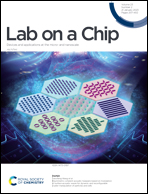SARS-CoV-2 proteins monitored by long-range surface plasmon field-enhanced Raman scattering with hybrid bowtie nanoaperture arrays and nanocavities†
Abstract
The identification of biomacromolecules by using surface-enhanced Raman scattering (SERS) remains a challenge because of the near-field effect of traditional substrates. Long-range surface plasmon resonance (LRSPR) is a special type of surface optical phenomenon that provides higher electromagnetic field enhancement and longer penetration depth than conventional surface plasmon resonance. To break the limit of SERS detection distance and obtain a SERS substrate with increased enhancement ability, a bowtie nanoaperture array was sandwiched between two symmetric dielectric environments. Then, an Au mirror was inserted to form a metal–insulator–metal configuration. Finite-difference time-domain simulations revealed that numerous hybrid modes can be provided by this novel configuration (denoted as long-range SERS [LR-SERS] substrate). In particular, the LRSPR mode can be excited and reach the maximum value through the regulation of the polarizations of the incident light and the geometrical parameters of the LR-SERS substrate. The optimized LR-SERS substrate was then applied to detect SARS-CoV-2 spike (S) and nucleocapsid (N) proteins. This substrate displayed ultralow detection limits of ∼9.2 and ∼11.3 pg mL−1 for the S and N proteins, respectively. Moreover, with the help of principal component analysis and receiver operating characteristic methods, our fabricated sensors exhibited excellent selectivity and hold great potential for the diagnosis of SARS-CoV-2 proteins in real samples.



 Please wait while we load your content...
Please wait while we load your content...